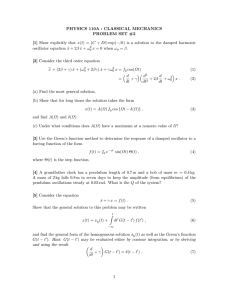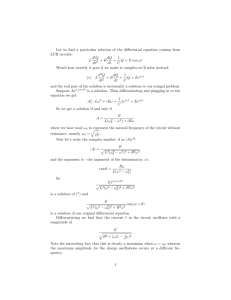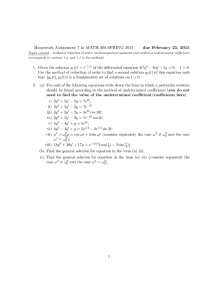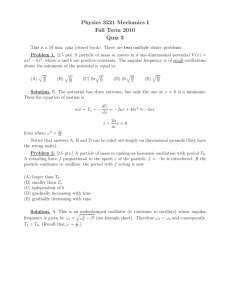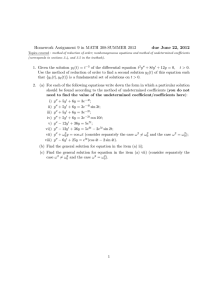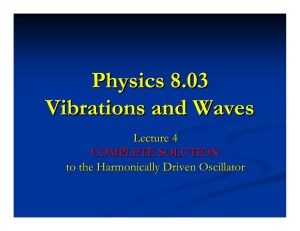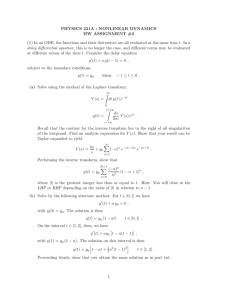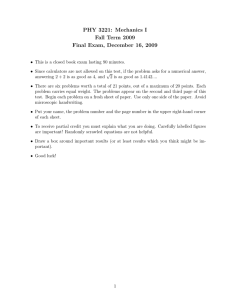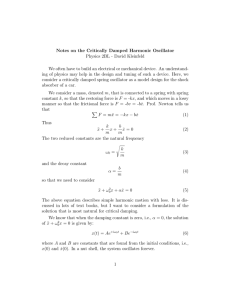Lecture 2: Driven oscillators
advertisement
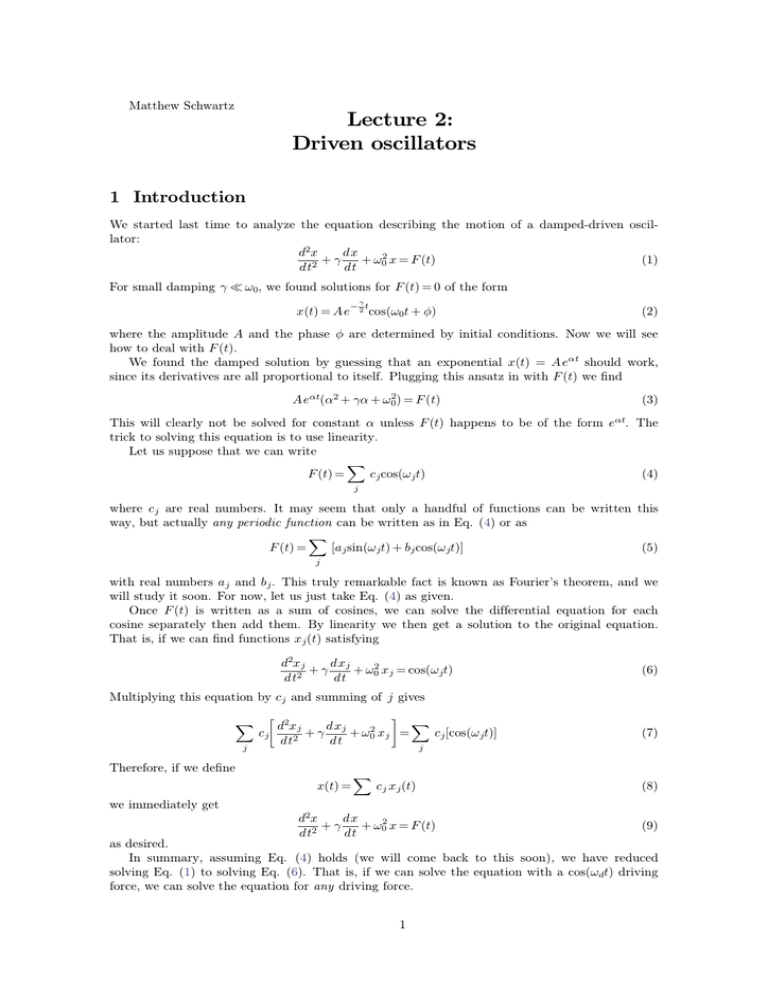
Matthew Schwartz Lecture 2: Driven oscillators 1 Introduction We started last time to analyze the equation describing the motion of a damped-driven oscillator: dx d2x +γ + ω02 x = F (t) (1) dt dt2 For small damping γ ≪ ω0, we found solutions for F (t) = 0 of the form γ x(t) = Ae −2t cos(ω0t + φ) (2) where the amplitude A and the phase φ are determined by initial conditions. Now we will see how to deal with F (t). We found the damped solution by guessing that an exponential x(t) = A eαt should work, since its derivatives are all proportional to itself. Plugging this ansatz in with F (t) we find Aeαt(α2 + γα + ω02) = F (t) (3) This will clearly not be solved for constant α unless F (t) happens to be of the form eαt. The trick to solving this equation is to use linearity. Let us suppose that we can write X c j cos(ω jt) (4) F (t) = j where cj are real numbers. It may seem that only a handful of functions can be written this way, but actually any periodic function can be written as in Eq. (4) or as X F (t) = [a j sin(ω jt) + bj cos(ω jt)] (5) j with real numbers a j and bj . This truly remarkable fact is known as Fourier’s theorem, and we will study it soon. For now, let us just take Eq. (4) as given. Once F (t) is written as a sum of cosines, we can solve the differential equation for each cosine separately then add them. By linearity we then get a solution to the original equation. That is, if we can find functions x j (t) satisfying dx d2x j + γ j + ω02 x j = cos(ωjt) dt dt2 (6) Multiplying this equation by c j and summing of j gives X j cj X d2x j dx j 2 cj [cos(ω jt)] +γ + ω0 x j = dt2 dt (7) j Therefore, if we define x(t) = we immediately get X c j x j (t) d2x dx +γ + ω02 x = F (t) dt2 dt (8) (9) as desired. In summary, assuming Eq. (4) holds (we will come back to this soon), we have reduced solving Eq. (1) to solving Eq. (6). That is, if we can solve the equation with a cos(ωdt) driving force, we can solve the equation for any driving force. 1 2 Section 2 2 Driven oscillator Our first task is to solve dx F d2x +γ + ω02 x = 0 cos(ωdt) dt m dt2 (10) Here we have made the normalization more physical by adding F0, for the strength of force with units of force, and dividing by the oscillator mass m to get an acceleration (the left hand side d2x has units of acceleration, as in dt2 ). What’s a good guess for a solution? Trying x(t) = cos(ωdt) or x(t) = sin(ωdt) will not work since there are first and second derivatives in the equation. We need exponentials. The key to turning the problem from cosines into exponentials is to recall that e−iωt = cos(ωt) − i sin(ωt) (11) cos(ωdt) = Re(e−i ωdt) (12) d2 d F z + γ z + ω02 z = 0 e−iωdt dt2 dt m (13) so that Now suppose we find a solution to with a complex function z(t). Then we define x(t) ≡ Re [z(t)] (14) Taking the real part of Eq. (13) then gives 2 d F0 −iωdt d 2 z + γ z + ω z = Re e Re 0 dt m dt2 (15) which is exactly Eq. (10). So we have reduced the problem to using an exponential driving force instead of a cosine driving force. Plugging in a guess z(t) = Ce−i ωdt into Eq. (15) gives Ce−i ωdt[−ωd2 − iγωd + ω02] = F0 −iωdt e m (16) Now the eiωdt factors drop out and we have a simple algebraic relation C= Thus z(t) = 1 F0 m ω02 − iγωd − ωd2 F0 1 e−iωdt m ω02 − iγωd − ωd2 To get the solution to the original equation with a real function x(t) we use Eq. (14): F0 1 −iωdt x(t) = Re e m ω02 − iγωd − ωd2 (17) (18) (19) Now we just have to simplify this using algebra. First, we get the i ′s to the numerator by writing where 1 ω02 − ωd2 + iγωd 1 ω02 − ωd2 + iγωd = = ω02 − iγωd − ωd2 ω02 − ωd2 + iγωd ω02 − ωd2 − iγωd (ω02 − ωd2)2 +(γωd)2 (20) ≡A + Bi (21) γωd ω02 − ωd2 B= 2 2 2 2 2 2 2 (ω0 − ωd) +(γωd)2 (ω0 − ωd) + (γωd) F F x(t) = Re 0 (A + Bi)e−iωdt = 0 Re[(A + Bi)(cos(ωdt) − i sin(ωdt))] m m A= Then = F0 (A cosωdt + B sinωdt) m (22) (23) (24) 3 Driven oscillator In summary, we found an exact solution to Eq. (10): F0 γωd ω02 − ωd2 x(t) = cosωdt + 2 sinωdt m (ω02 − ωd2)2 +(γωd)2 (ω0 − ωd2)2 +(γωd)2 (25) 2.1 Transients We found a single exact solution. What happened to the boundary conditions? The dependence on boundary conditions is entirely determined by solutions to the homogeneous equation, with F = 0: d2x0 dx + γ 0 + ω02 x0 = 0 (26) dt2 dt Solutions to this equation are called homogeneous solutions. The solution x(t) in Eq. (25) is called the inhomogeneous solution. Note that x0(t) + x(t) will also satisfy the inhomogeneous Eq. (10), due to linearity. Thus we can always add a homogeneous solution to an inhomogeγ −2t factors, plus posneous solution. We saw before that the homogeneous solutions all have e sibly some oscillatory component. Thus they die off at late time. For this reason, they are called transient. Transients are determined by boundary conditions. If you have a driving force for long enough time, then the transient is irrelevant. 2.2 Phase lag A good way to see the physics hidden in the solution x(t) is to take limits. First, consider the limit with no damping, γ = 0. Then, x(t) = 1 F0 cosωdt m ω02 − ωd2 (27) We can compare this to our driving force F (t) = F0cosωdt. For ωd < ω0 the sign of the position and the force are the same so they are exactly in phase. Now say we crank up the driving frequency ωd until it reaches then surpasses ω0. For ωd > ω0, the sign of the solution flips and the oscillator is out out of phase with the driver. Physically, the oscillator can’t keep up with the driving force: it experiences phase lag. 2.3 Power and energy We see from Eq. (25) there is a part of x(t) which is exactly proportional to the driving force F (t) = F0cosωdt and a part which is out of phase. We call the in-phase part the elastic amplitude. It is proportional to ω02 − ωd2 (28) A= 2 (ω0 − ωd2)2 +(γωd)2 The out-of-phase part is the absorptive amplitude. Its magnitude is B= γωd (ω02 − ωd2)2 + (γωd)2 (29) Thus for γ = 0, no damping, there is no absorptive part. Since the absorptive part is proportional to γ it should have to do with energy being lost from the oscillator into the system. To see how this works, we need to compute the energy and the power. Recall that work is force times displacement W = F ∆x and power is work per unit time: P= W ∆x =F ∆t ∆t (30) For small displacements and small times, this becomes P =F dx dt (31) 4 Section 2 Plugging in our solution x(t) = F0 [A cos(ωdt) + B m sin(ωdt)] F0 F0 P = F0cos(ωdt) −ωd A sin(ωdt) + ωd B cos(ωdt) m m =− (32) F02 F2 ωdA sin(2ωdt) + 0 Bωd cos2(ωdt) 2m m (33) 1.0 1.0 0.5 0.5 power power where 2sinθcosθ = sin(2θ) has been used. This is the power put into the system by the driving force. We see that the absorptive part is proportional to cos2ωdt which is positive for all times. Thus it always takes (absorbs) power. On the other hand, the elastic amplitude is proportional to sin(2ωdt) which is sometimes positive and sometimes negative. These are shown here 0.0 - 0.5 - 0.5 - 1.0 0.0 0 2 4 6 8 - 1.0 10 0 2 4 6 8 10 time time absorptive amplitude always takes power (P>0) elastic amplitude sometimes takes power (P>0) sometimes gives power back (P<0) Figure 1. Absorptive and elastic amplitudes When the power is negative, as in the elastic amplitude, the oscillator is returning power to the driver. The elastic amplitude averages to zero. Since γ = 0 implies that the absorptive amplitude vanishes so the entire solution is elastic, we draw the logical conclusion that with no damping (γ = 0) no net power is needed to drive the system (a little power is needed to get it started, but once it’s moving, the driver no longer does work). 2π The average power put into the system is over a period T = ω is d hP i = 1 T Z 0 T dtP (t) = F02 Bωd = 2m F02 (γωd)2 2 2γm (ω0 − ωd2)2 +(γωd)2 (34) Here is a plot of this average power as a function of ωd for fixed γ and ω0. Figure 2. Power absorbed for γ = 2 and ω0 = 5 as a function of the driving frequency ωd. The maximum is when ωd = ω0 known as resonance. The dashed line is half of the maximum power. The length of the dashed line between the points where it hits the curve (width at half-maximum) is γ. 5 Driven oscillator This power absorption curve has a maximum at ωd = ω0 (you can check this) where hP i = This is known as a resonance.γ. One way to find the resonance frequency ω0 of a system is by varying the driving force until maximum power is absorbed. The power is half the resonant F02 . 2γm F2 0 power, hP i = 4γm , when ωd = 1 1p 2 4ω0 + γ 2 ± γ 2 2 (35) The difference between these two driving frequencies is γ. Thus, one can also read γ off of the plot in Fig. 2: it is the value of the width at half-maximum. This kind of curve is called a Lorentzian. Its maximum is at ω0 and its width is γ.
